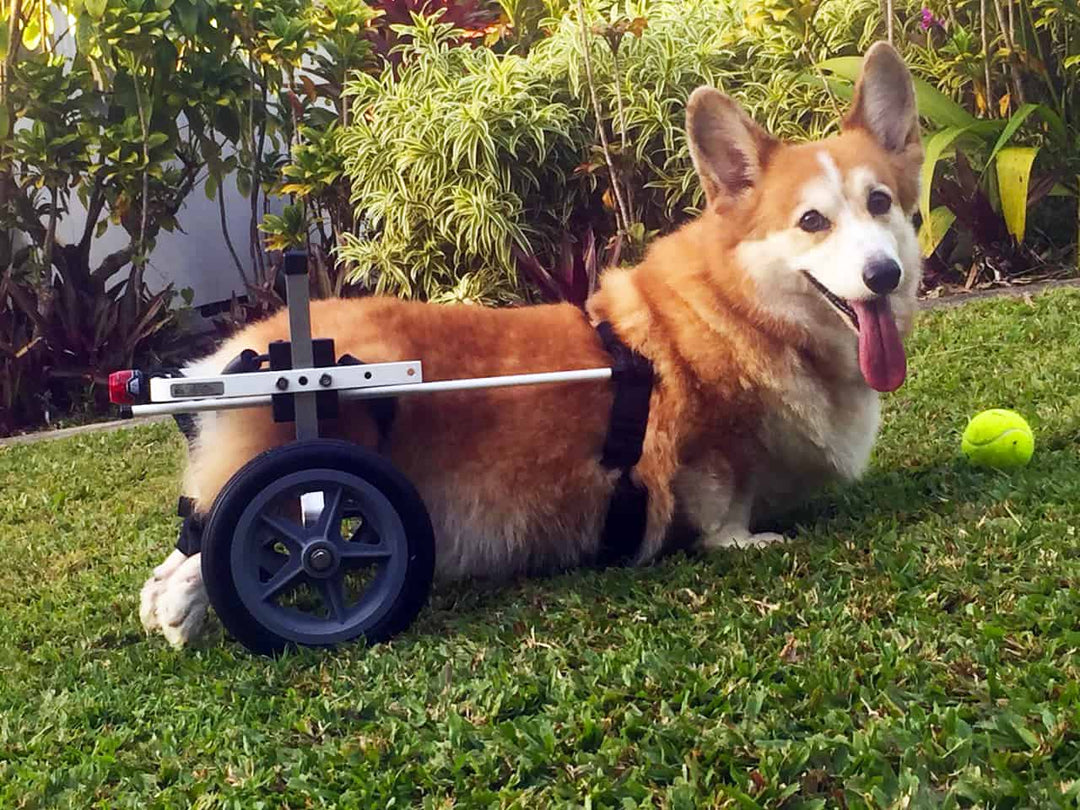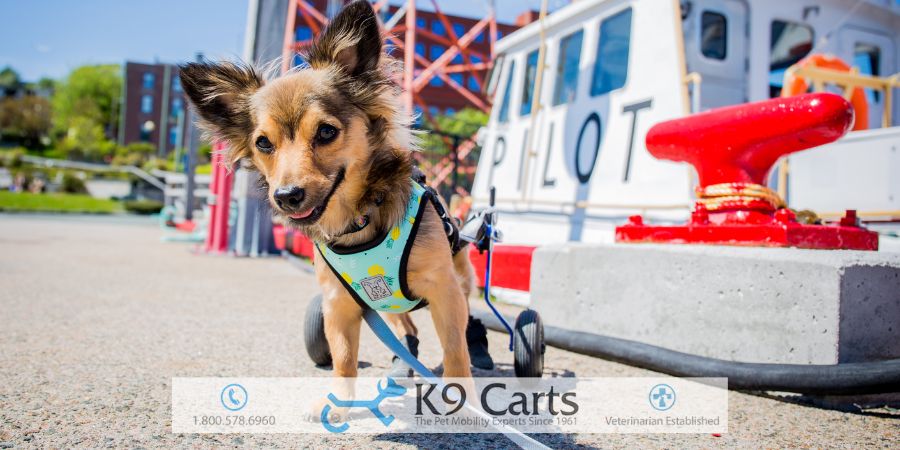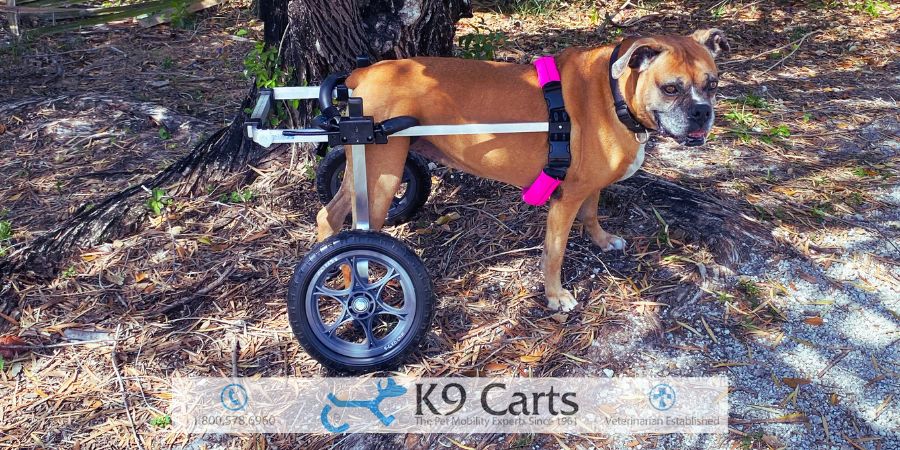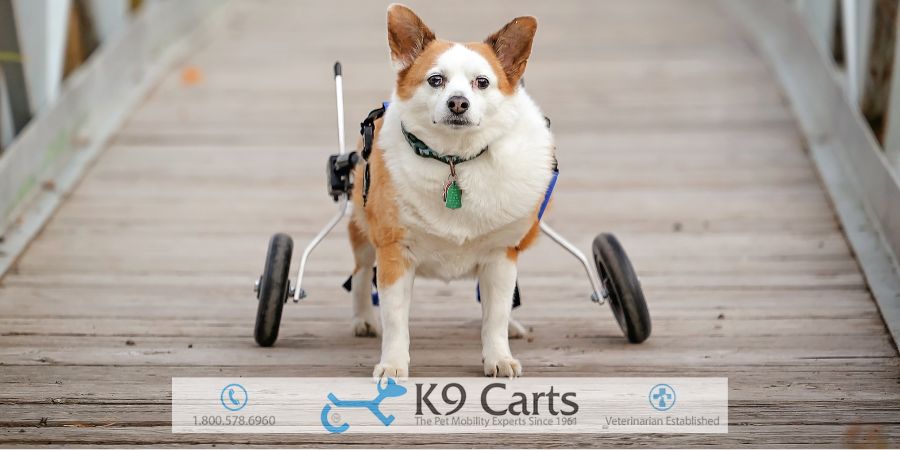Doggie Wheelchair Success Stories: Daisy Mei and Joseph

We’re back with another success story! Here at K9 Carts, we channel our passion for pets into creating customized carts that allow dogs, cats, and even chickens to regain mobility and improve their quality of life. Every pet is unique, and we relish the chance to get to know each individual case and create a cart that serves that animal well. Degenerative myelopathy (DM) is a progressive disease of the spinal cord that generally affects older Pembroke Welsh Corgis, German Shepherds, and Boxers. As the spinal cord degenerates, the dog begins to experience hind limb weakness and eventually loses the use of his or her rear limbs. Today, we’re taking a look at two special dogs that were affected by this disease. They have since passed away, but their story serves as an important reminder that paralyzed canines are perfectly capable of living happy lives.


Daisy Mei and Joseph
If you’ve ever met a Pembroke Welsh Corgi, you know that they’re some of the friendliest, spunkiest dogs around. Their long torsos, stubby legs, and short tails give them an adorable, perpetually enthusiastic look. Daisy Mei and Joseph were perfect, fun-loving examples of the breed. “Daisy Mei ruled the land and all the tennis balls,” said pet parent Allen C. Johnson, M.D. “Joseph’s domain was the water. Daisy hated to swim. Joseph loved it. He would throw himself into the pool to get the tennis ball, and he was a powerful swimmer.” The pair enjoyed daily walks by the seashore and plenty of attention from visiting tourists. Unfortunately, Corgis are also predisposed to developing degenerative myelopathy, and Daisy Mei began to show signs of DM in 2013. While her right hind leg remained very strong, her left hind leg grew weak. This manifested as a gait disturbance, which resulted in injuries to her left rear foot. In September 2017, Allen noticed the first signs of Joseph’s DM: when Joseph dove into the pool, his stronger hind leg flipped him over, and he sank. “This scared him so much that he never wanted to go into the water again, even with a doggie life vest,” said Allen. And as Joseph weakened, he became less interested in life. “I took him to the beachfront every morning of his life, but he would only want to walk as little as necessary for his potty needs, then just go home,” Allen said.
Getting the Corgis Back on Their Feet with Custom Dog Wheelchairs
After the onset of Daisy Mei’s DM in 2013, Allen took to the internet to research his options. That’s where he came across K9 Carts. Upon hearing of Daisy Mei’s condition, we got right to work designing and building a dog wheelchair for back legs that would give her the support she needed. “Daisy Mei took to the cart right away,” Allen said. “She was faster in her cart than Joseph was on four legs. She could even get it off the ground to jump for the tennis ball.” Daisy Mei enjoyed romps on the beach in her cart for the next two years. And, when Joseph’s diagnosis came, Allen knew exactly where to turn. While it doesn’t take long for most dogs to get used to the cart, Joseph needed a little extra time. “When we first tried it, he planted his feet and refused to move,” said Allen. Joseph’s hind legs grew weaker, and when Allen brought out the cart again, the little dog was ready for it. “The next time I introduced the cart, he took to it right away and grew completely dependent on it for the last year of his life.” With the help of a dog wheelchair, Daisy Mei and Joseph were once again able to enjoy their morning walks on the beach. Joseph even had a bicycle light affixed to his cart for safer evening walks. “Joseph soon realized he was even more of a tourist magnet in his cart,” said Allen. “When he noticed someone approaching who looked like a good prospect, he would turn and bark at me. That was the sign to get a tennis ball out of my bag and throw it so he could show off for the crowd.”Creating a Unique Cart
Because every dog is different, each of our carts is also different. We’re always learning new things and coming up with creative solutions as pet parents take their newly-mobile dogs on varied adventures. Daisy Mei was a smaller Corgi, so our 6-inch wheels were the perfect fit for her custom cart—but they became a special issue when the ocean came into play. “On her morning walk at the beach, she did not hesitate to head straight for the water, climb the rocks, and settle down in a tide pool,” said Allen. He eventually worked out a system of drilling a hole into the hub and spraying in WD-40 after each walk to keep the wheels from degrading, but he still found himself replacing quite a few wheels as Daisy Mei continued to splash about in the water. When Joseph was on his second set of 6-inch wheels, Allen consulted with Glenn, General Manager of K9 Carts. “He made up a super cool looking set of 8-inch wheels with stainless steel hardware,” said Allen. “Joseph was very proud of them, and they lasted the rest of his life.” Allen credits K9 Carts with helping both of his Corgis regain their mobility and interest in life. “The cart kept them mobile and happy, and that made our lives so much better. Without a cart, they would have been miserable and died at least a year sooner,” he said. “The K9 Cart is an elegantly simple device that performs miracles; it keeps animals alive.”
Pet Wheelchairs for Animals Big and Small
Whether your furry friend is suffering from degenerative myelopathy or in need of surgical rehabilitation, we’re here to help! As the experts in pet mobility, we’ve spent years researching, designing, and building customized pet wheelchairs that give animals a new lease on life. We’d love to help you get your pet back on his or her feet again—give us a call today to learn more about our carts and other mobility aids.
More from:
Client Spotlight






